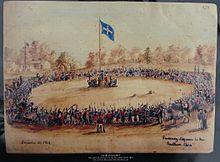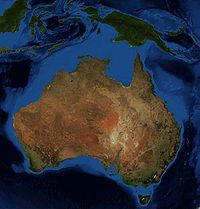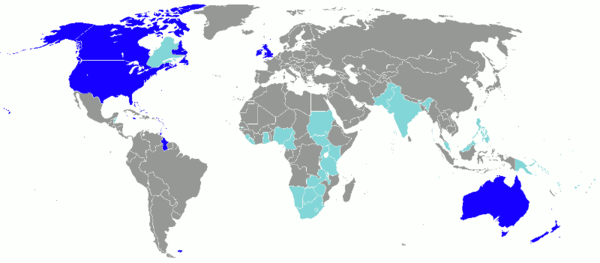- Australian English
-
Australian English (AusE, AuE, AusEng, en-AU[1]) is the name given to the group of dialects spoken in Australia that form a major variety of the English language.
Despite being given no official status in the constitution, English is Australia's de facto official language and is the first language of, and is used exclusively by, the vast majority of the population.
Australian English was distinctly recognisable as different from British English shortly after the founding of the colony of New South Wales in 1788. It arose from the intermingling of children of early settlers from a great variety of mutually intelligible dialectal regions of the British Isles and quickly developed into a major variety of English.[2]
Contents
Origins
The earliest form of Australian English was first spoken by the children of the colonists born into the colony of New South Wales. This very first generation of children created a new dialect that was to become the language of the nation. The Australian-born children in the new colony were exposed to a wide range of different dialects from all over the British Isles, in particular from Ireland and South East England, with a large proportion of Cockneys.[3]
The native-born children of the colony created the new dialect from factors present in the speech they heard around them, and provided an avenue for the expression of peer solidarity. Even when new settlers arrived, this new dialect was strong enough to deflect the influence of other patterns of speech.
A large part of the convict body were the Irish, with at least 25% directly from Ireland, and others indirectly via Britain. There were other significant populations of convicts from non-English speaking areas of Britain, such as the Scottish Highlands and Wales.
Records from the early 19th century survive to this day describing the distinct dialect that had surfaced in the colonies since first settlement in 1788,[2] with Peter Miller Cunningham's 1827 book Two Years in New South Wales, describing the distinctive accent and vocabulary of the native born colonists, different to that of their parents and with a strong Cockney influence.
Influences
 The Australian gold rushes saw many external influences adopted into the language.
The Australian gold rushes saw many external influences adopted into the language.
The first of the Australian gold rushes, in the 1850s, began a large wave of immigration, with approximately two per cent of the population of the United Kingdom emigrating to the colonies of New South Wales and Victoria.[4]
This great influx of immigrants caused the integration of numerous new patterns into the local speech. By this time several words of Irish origin had been adopted into the language, some of which are also common elsewhere in the Irish diaspora, such as tucker for "food", "provisions" (Irish tacar),[citation needed] as well as one or two native English words whose meanings have changed under Irish influence,[citation needed] such as paddock for "field", cf. Irish páirc, which has exactly the same meaning as the Australian paddock.
Some elements of Aboriginal languages and Torres Strait Island languages have been adopted by Australian English—mainly as names for places, flora and fauna (for example dingo) and local culture. Many such are localised, and do not form part of general Australian use, while others, such as kangaroo, boomerang, budgerigar, wallaby and so on have become international. Other examples are cooee and hard yakka. The former is used as a high-pitched call, for attracting attention, (pronounced /kʉː.iː/) which travels long distances. Cooee is also a notional distance: if he's within cooee, we'll spot him. Hard yakka means hard work and is derived from yakka, from the Yagara/Jagara language once spoken in the Brisbane region.
Also from there is the word bung, from the Sydney pidgin English (and ultimately from the Sydney Aboriginal language), and originally meaning "dead", and now meaning "broken" or "caused to be less than perfect". Many towns or suburbs of Australia have also been influenced or named after Aboriginal words. The most well known example is the capital, Canberra named after a local language word meaning "meeting place".
Among the changes brought by the 19th century gold rushes was the introduction of words, spellings, terms and usages from North American English. The words imported included some later considered to be typically Australian, such as dirt and digger and bonzer.[5] The influx of American military personnel in World War II brought further American influence; seen in the enduring persistence of okay, you guys and gee.[5] The American influence on North Queensland during and after World War II led to the localised adoption of terms such as bronco for the native brumby meaning wild horse, and cowboy for the native drover for a cattle or sheep herder.
Since the advent of film, however, the American influence on language in Australia has mostly come from popular culture and media. Where British and American vocabulary differs, Australians will in some cases favour an Australian usage (such as capsicum (for US bell pepper, UK red or green pepper), in some cases favour an American usage (such as eggplant for UK aubergine), and in some cases favour a British usage (such as mobile phone for US cell phone).
Sociocultural variation
Three main varieties of Australian English are spoken according to linguists: broad, general and cultivated.[6] They are part of a continuum, reflecting variations in accent. They can, but do not always reflect the social class, education and urban or rural background of the speaker.[7]
Broad Australian
Broad Australian English is recognisable and familiar to English speakers around the world and is prevalent nationwide, but is especially strong in rural areas. Examples of people with this accent are Steve Irwin, Paul Hogan and Julia Gillard. In Australia, this dialect is sometimes called Strine (or "Strayan"), a shortening of the word Australian, and a speaker of the dialect may be referred to as an Ocker.
Tests indicated that the Broad speakers demonstrated a greater tendency for syllable assimilation and consonant elision, were more likely to use weak consonants or restricted intonation (narrow pitch range), were more likely to speak slowly (drawl), and further, showed a greater tendency to exhibit pervasive nasality.
General Australian
The most common of Australian accents is known as General Australian English, and is used as a standard language for the purposes of television news broadcasts and advertising. This accent is especially prominent in urban Australia and it predominates in modern Australian films and television programmes and is used by, for example, Hugh Jackman, John Howard and Eric Bana.
Cultivated Australian
Cultivated Australian English has some similarities to Received Pronunciation. It has become less common especially amongst younger generations. Cultivated Australian English has in the past been thought to indicate high social class or education, and is spoken by Kevin Rudd, Malcolm Fraser and Geoffrey Rush.
Aboriginal and Torres Strait Islander English
Main article: Australian Aboriginal EnglishAustralian Aboriginal English refers to a dialect of Australian English used by a large proportion of Indigenous Australians. It is made up of a range of forms which developed differently in different parts of Australia, and are said to vary along a continuum, from forms close to Standard Australian English to more non-standard forms. There are distinctive features of accent, grammar, words and meanings, as well as language use. The dialect is not to be confused with Australian Kriol language, which is not mutually intelligible with Australian English but in fact a separate language spoken by over 30,000 people. On the Torres Strait Islands, a distinctive dialect known as Torres Strait English, the furthest extent of which is Torres Strait Creole, is spoken.[8]
Ethnocultural varieties
The ethnocultural dialects are diverse accents in Australian English that are spoken by the minority groups, which are of non-English speaking background.[9] A massive immigration from Asia and the Middle East has made a large increase in diversity and the will for people to show their cultural identity within the Australian context.[10] These ethnocultural varieties contain features of General Australian English as adopted by the children of immigrants blended with some non-English language features, such as the Afro-Asiatic and Asian languages.[8]
Phonological features
Main article: Australian English phonology- Australian English is a non-rhotic accent that is highly distinctive from other varieties of English. It shares most similarity with other Southern Hemisphere accents, in particular New Zealand English.[11] Like most dialects of English it is distinguished primarily by its vowel phonology.[12]
- The vowels of Australian English can be divided into two categories: long and short vowels. The short vowels, consisting only of monophthongs, are similar to the lax vowels in British and North American English.
- The long vowels, consisting of both monophthongs and diphthongs, mostly correspond to its tense vowels and centring diphthongs. Unlike most varieties of English, it has a phonemic length distinction: that compresses, shortens or removes these features.[13]
- The Australian English vowels /ɪ/, /e/,/æ/,/ɜː/,/ə/, and /oː/ are noticeably closer (higher tongue position) than their RP (British Received Pronunciation) equivalents. The centring diphthongs are accordingly also closer in AE than RP.
- A long /æː/ sound is found in the adjectives bad, mad, glad and sad, before the /ɡ/ sound (for example, hag, rag, bag) and also in content words before /m/ and /n/ in the same syllable (for example, ham, tan, plant).[14]
- In some speakers, especially those with the Broad accent, the vowel in words like dad, back and lag will be shifted toward [ɛ].[15]
- In some varieties of Australian English, bad (with long [æː]) and lad (with short [æ]) do not rhyme (see bad–lad split).
- For many speakers, the /æː/ sound is flatter than the British /æː/.
- There is æ-tensing before a nasal consonant—The nasal sounds create changes in preceding vowels because air can flow into the nose during the vowel. Nasal consonants can also affect the articulation of a vowel. So for several speakers, the /æː/ vowel in words like "jam", "man", "dam" and "hand" will be shifted towards [e].[16]
- The /aː/ sound, an open unrounded vowel, is used in words like car, bath, ask, father and pass. So the words like trap and bath wouldn't have the same vowel (see Trap–bath split).
- However, words like chance, plant, branch, sample (words containing the suffix -mand, -ant, -anch, -ance) mostly have an /æ/ vowel as in cat but there are some speakers who use the vowel in cart (/aː/) for these words, particularly in South Australia, which had a different settlement chronology and type than other parts of the country. Comparatively, most of the British accents use the back /ɑː/ sound.[17]
- The /e/ sound, which is a high-mid front unrounded vowel, is predominantly used in words like, dress, pet, bed and head. Comparatively, in most of American and British English, an [ɛ] sound is used instead, which is a low-mid front vowel.[18]
- The /ɪ/ sound, used in tin, bit and sit, tends to be tenser than in other varieties of English, and may sometimes sound like it's shifted to /i/ in the foreign ear.[19] Thus, words like pin and kin will sound almost similar to peen and keen in the foreign ear. The final vowel in words like “happy” and “city”, which is typically /i/, is elongated to an /i:/ sound, so both will sound like happee and citee, respectively.[20] Some of these aforementioned features are present in Chicano English.
- Diphthongs
- For many speakers, the vowel in words like "town" and "now" is [æʊ].
- The vowel in words like "neat" and "feet" is [ei] sound where, for example, "neat" will be [neiʔ].
- The vowel in "fate" is [æɪ] for several speakers, so words like that will sound like [fæɪʔ].
- The vowel in "high" may be [ɑɪ] for those with the Broad accent, so "buy" might sound like "boy" in the foreign ear. This is a direct influence from the Cockney accent. Some of these features aforementioned are also present in the New York accent.[21]
- Australian accent is R-less; in other words, the [r] sound does not appear at the end of a syllable or immediately before a consonant. A final -er is pronounced as lowered [ɐ] in most speakers, or [ə] for some. So the words butter [bɐɾə], here [hɪɐ] and park [paːk] will not contain the /r/ sound.[22]
- Intervocalic /t/ and /d/ undergoes voicing and flapping to the alveolar tap [ɾ] after the stressed syllable and before unstressed vowels (as in butter, party) and syllabic /l/, though not before syllabic /n/ (bottle vs button [batn]), as well as at the end of a word or morpheme before any vowel (what else, whatever). There will be a homophony if some words are flapped, for example, metal and petal will sound like medal and pedal. In formal speech /t/ is retained. When coating becomes coatin' , the t remains voiceless, thus [kʌutn]. The cluster [nt] can also be flapped/tapped. As a result, in quick speech, words like winner and winter can become homophonous. This is a quality that Australian English shares most notably with North American English.
- Linking and intrusive R or epenthetic /r/
- The /r/ sound can occur when a word that has a final “r” in the spelling comes before another word that starts with a vowel. For example, in “car alarm” the sound /r/ can occur in “car” because here it comes before another word beginning with a vowel. The words “far”, “far more” and “farm” do not contain an /r/ but “far out” will contain the linking /r/ sound because the next word starts with a vowel sound.
- An intrusive /r/ may be inserted before a vowel in words that do not have “r” in the spelling. For example, "drawing" will sound like "draw-ring", "saw it" will sound like "sore it", "the tuner is" and "the tuna is" will both be /ðə tjʉːnərɪz/.
- For some speakers, a subtle epethentic /r/ may be added after the əʉ (M.-D. /oʊ/) sound in words like "no" [nəʉr], "hello" [həˈləʊr], "don't" [dəʊ-rnt] and "low" [ləʊr].
- Yod coalescence
- Yod coalescence occurs in /dj/, /sj/ and /tj/ into /dʒ/, /ʃ/ and /tʃ/, producing standard pronunciations such as [t͡ʃʰʉːn] for tune, /ʃɹiˈlæŋkə/ for Sri Lanka and /dʒɹɔː/ for draw. The sound /j/ occurs in Australian English at the beginning of words like "yellow" and "yes" and it also occurs in words like "new" and "tube". An affricate also occurs in "dune", where it will be pronounced exactly like "June". In the case of /dʒ/, this palatalisation can lead to additional homophony where dew, due, and Jew come to be pronounced identically.
- Australian English speakers commonly use a form of upward inflection in their speech that is not associated with asking questions. In English, upward inflection (a rise in the pitch of the voice at the end of a sentence) typically signals a question. However, some speakers also use upward inflection as a way of including their conversational partner in the dialogue.[23] This is also common in Californian English.
Regional differences
Main article: Regional variation in Australian EnglishAustralian English is relatively homogenous when compared to British and American English. There is however some regional variation between the states, particularly in regards to South Australia, Victoria and Western Australia.
Different word usage
Most regional differences come down to word usage. For example, swimmers (New South Wales) are known as togs in Queensland and bathers in Victoria and South Australia. Distinctive grammatical patterns also exist such as the use of the interrogative eh? and the position of the word but at the end of a sentence in Queensland ("But I don't like him" becomes "I don't like him but").
Trap–bath split
Main article: Phonological history of English short AIn Australian English, pronunciations vary regionally according to the type of vowel that occurs before the sounds nd, ns, nt, nce, nch, and mple, and the pronunciation of the suffix "-mand". In words like "chance", "plant", "graph", "branch", "sample" and "demand", the vast majority of Australians use the short /æ/ vowel from the word "cat". In South Australia however a high proportion of people use the broad /aː/ vowel from the word "cart" in these words. For some speakers, particularly in Victoria, the "a" vowel in "castle" and "rascal" rhymes with "hassle" rather than non-rhotic "parcel". Also, some may use a short "a" vowel in "bat" for words like "grasp", "gasp", "plaque" and "rasp".[24]
Western Australia—Centring diphthongs
Main article: Western Australian EnglishCentring diphthongs, which are the vowels that occur in words like near, square and cure. In the Eastern states, these may be realised either as diphthongs (e.g. [fiə] or [fiʌ] 'fear'), or as monophthongs (e.g. [fiː]). This does not usually occur in Western Australia, where the diphthongs are typically realised fully. For example, those in the eastern states will tend to pronounce "fear" and "sheer" without any jaw movement, while the westerners would pronounce them like "fia" and "shia", respectively.[25]
South Australia—"L" vocalisation
Main article: South Australian EnglishWhen the consonant "l" occurs at the ends of words before pauses and before consonants it sometimes sounds like a vowel sound rather than a consonant. This is because /l/ is made with two different articulations. One of the articulations is like a vowel articulation and the other is more like a typical consonant articulation. When /l/ occurs at the ends of words before pauses and before other consonants, the consonantal articulation can be obscured by the vowel articulation. This makes the /l/ sound like "oo".[26]
The tendency for some /l/ sounds to become vowels (/l/ L vocalization) is more common in South Australia than other states. "Milk", for example, in South Australia has a vocalised /l/, leading to the pronunciation "miwk", whereas in other states the /l/ is pronounced as a consonant.
Victoria—Salary–celery merger
In Victoria, many speakers pronounce the "a" and "e" vowels in a way that is distinct from speakers in other states. For many younger speakers from Victoria, the first vowel in "celery" and "salary" are the same, so that both words sound like "salary". These speakers will also tend to say "halicopter" instead of "helicopter".[citation needed] For many older Victorian speakers, the words "celery" and "salary" also sound the same but instead both sound like "celery". These speakers will also pronounce words such as "alps" as "elps".
Southern/Eastern states—Pool, school variation
The vowel in words like "pool", "school" and "fool" varies regionally.
Vocabulary
Main article: Australian English vocabulary Bush poets such as Banjo Paterson captured the Australian vocabulary of the 19th century in their bush ballads.
Bush poets such as Banjo Paterson captured the Australian vocabulary of the 19th century in their bush ballads.
Australian English has many words and idioms which are unique to the dialect and have been written on extensively, with the Macquarie Dictionary, widely regarded as the national standard, incorporating numerous Australian terms.
Internationally well-known examples of Australian terminology include outback, meaning a remote, sparsely populated area, the bush, meaning either a native forest or a country area in general, and g'day, a greeting. Dinkum, or fair dinkum means "true", or "is that true?", among other things, depending on context and inflection.[27] The derivative dinky-di means 'true' or devoted: a 'dinky-di Aussie' is a 'true Australian'.
Australian poetry, such as The Man from Snowy River, and folk songs, such as Waltzing Matilda, contain many historical Australian words and phrases that are understood by Australians even though some are not in common usage today.
Australian English, in common with several British English dialects (for example, Cockney, Scouse, Glaswegian and Geordie) use the word mate. Many words used by Australians were at one time used in England but have since fallen out of usage or changed in meaning.
For example, creek in Australia, as in North America, means a stream or small river, whereas in the UK it means a small watercourse flowing into the sea; paddock in Australia means field, whereas in the UK it means a small enclosure for livestock; bush or scrub in Australia, as in North America, means a wooded area, whereas in England they are commonly used only in proper names (such as Shepherd's Bush and Wormwood Scrubs).
Litotes, such as "not bad", "not much" and "you're not wrong", are also used, as are diminutives, which are commonly used and are often used to indicate familiarity. Some common examples are arvo (afternoon), barbie (barbecue), smoko (morning tea), Aussie (Australian) and pressie (gift). This may also be done with people's names to create nicknames (other English speaking countries create similar diminutives). For example, "Gazza" from Gary.
In informal speech, incomplete comparisons are sometimes used, such as "sweet as". "Full", "fully" or "heaps" may precede a word to act as an intensifier. This is more common in regional Australia and South Australia. The suffix "-ly" is sometimes omitted in broader Australian English. For instance "real good" in lieu of "really good."
Spelling and grammar
As in most English speaking countries, there is no official governmental regulator or overseer of correct spelling and grammar. The Macquarie Dictionary is used by universities and style guides as a standard for Australian English spelling.
Australian spelling generally follows conventions of British spelling. As in British spelling, the 'u' is retained in words such as honour and favour and the -ise ending is used in words such as organise and realise, although the older -ize also exists, but is far less common. Words listed by the Macquarie Dictionary as currently spelled differently to the received British spellings include "program" as opposed to "programme" and "jail" as opposed to "gaol".[28] Single quotation marks and unspaced em-dashes are preferred, and the DD/MM/YYYY date format is used.
Different spellings have existed throughout Australia's history. A pamphlet entitled The So-Called "American Spelling", published in Sydney some time in the 19th century, argued that "there is no valid etymological reason for the preservation of the u in such words as honor, labor, etc."[29]
The pamphlet also claimed that "the tendency of people in Australasia is to excise the u, and one of the Sydney morning papers habitually does this, while the other generally follows the older form."
This influence can be seen in the spelling of the Australian Labor Party, spelt without a 'u', with the atypical American spelling that was more common at the time of its formation in 1912. For a short time during the late 20th Century, Harry Lindgren's 1969 spelling reform proposal (Spelling Reform 1 or SR1) was popular in Australia and was adopted by the Australian government[citation needed]. SR1 calls for the short /e/ sound (as in bet) to be spelt with E (for example friend→frend, head→hed). Many general interest paperbacks were printed in SR1.
See also
- Australian English phonology
- Australian English vocabulary
- Australian Aboriginal English
- Australian Kriol language
- Strine
- New Zealand English
- IPA chart for English dialects
References
- ^
en-AUis the language code for Australian English , as defined by ISO standards (see ISO 639-1 and ISO 3166-1 alpha-2) and Internet standards (see IETF language tag). - ^ a b "history & accent change | Australian Voices". Clas.mq.edu.au. http://clas.mq.edu.au/australian-voices/history-accent-change. Retrieved 2011-07-26.
- ^ Moore, B., 2008, Speaking our language: The story of Australian English, Oxford University Press, Melbourne, p. 69.
- ^ Geoffrey Blainey, 1993, The Rush That Never Ended (4th ed.) Melbourne University Press
- ^ a b Bell, R. Americanization and Australia. UNSW Press (1998).
- ^ Robert Mannell (2009-08-14). "Robert Mannell, "Impressionistic Studies of Australian English Phonetics"". Ling.mq.edu.au. http://www.ling.mq.edu.au/speech/phonetics/phonetics/ausenglish/impressionistic.html. Retrieved 2011-07-26.
- ^ Australia's unique and evolving sound Edition 34, 2007 (23 August 2007) – The Macquarie Globe
- ^ a b "ethnocultural voices | Australian Voices". Clas.mq.edu.au. 2010-07-29. http://clas.mq.edu.au/australian-voices/ethnocultural-voices. Retrieved 2011-07-26.
- ^ "australian english | Australian Voices". Clas.mq.edu.au. 2010-07-30. http://clas.mq.edu.au/australian-voices/australian-english. Retrieved 2011-07-26.
- ^ "australian english defined | Australian Voices". Clas.mq.edu.au. 2009-10-25. http://clas.mq.edu.au/australian-voices/australian-english-defined. Retrieved 2011-07-26.
- ^ Trudgill, Peter and Jean Hannah. (2002). International English: A Guide to the Varieties of Standard English, 4th ed. London: Arnold. ISBN 0-340-80834-9, p. 4.
- ^ Harrington, J., F. Cox, and Z. Evans (1997). "An acoustic phonetic study of broad, general, and cultivated Australian English vowels". Australian Journal of Linguistics 17 (2): 155–84. doi:10.1080/07268609708599550.
- ^ Robert Mannell (2009-08-14). "Australian English - Impressionistic Phonetic Studies". Clas.mq.edu.au. http://clas.mq.edu.au/speech/phonetics/phonetics/ausenglish/impressionistic.html. Retrieved 2011-07-26.
- ^ Robert Mannell and Felicity Cox (2009-08-01). "Phonemic (Broad) Transcription of Australian English (MD)". Clas.mq.edu.au. http://clas.mq.edu.au/speech/phonetics/transcription/broad_transcription/broad_transcription_md.html. Retrieved 2011-07-26.
- ^ Robert Mannell and Felicity Cox (2009-08-01). "Phonemic (Broad) Transcription of Australian English (HCE)". Clas.mq.edu.au. http://clas.mq.edu.au/speech/phonetics/transcription/broad_transcription/broad_transcription.html. Retrieved 2011-07-26.
- ^ "further study | Australian Voices". Clas.mq.edu.au. 2010-07-29. http://clas.mq.edu.au/australian-voices/further-study. Retrieved 2011-07-26.
- ^ Robert Mannell and Jonathan Harrington (2009-08-01). "IPA Vowel Symbols". Clas.mq.edu.au. http://clas.mq.edu.au/speech/phonetics/transcription/ipa/ipa_vowel.html. Retrieved 2011-07-26.
- ^ Robert Mannell and Felicity Cox (2009-08-01). "Australian English Monophthongs". Clas.mq.edu.au. http://clas.mq.edu.au/speech/phonetics/phonetics/vowelgraphs/AusE_Monophthongs.html. Retrieved 2011-07-26.
- ^ "Distinctive Features". Clas.mq.edu.au. http://clas.mq.edu.au/speech/phonetics/phonology/features/index.html. Retrieved 2011-07-26.
- ^ http://clas.mq.edu.au/australian-voices/further-study
- ^ Accents of English from Around the World – University of Edinburough
- ^ "studying speech | Australian Voices". Clas.mq.edu.au. 2010-07-29. http://clas.mq.edu.au/australian-voices/studying-speech. Retrieved 2011-07-26.
- ^ "audio illustrations | Australian Voices". Clas.mq.edu.au. 2010-07-29. http://clas.mq.edu.au/voices/audio-illustrations. Retrieved 2011-10-17.
- ^ Felicity Cox and Robert Mannell (2009-08-09). "Australian English Transcription Practice Exercises - Orthography". Clas.mq.edu.au. http://clas.mq.edu.au/speech/phonetics/transcription/exercises/index.html. Retrieved 2011-07-26.
- ^ "regional accents | Australian Voices". Clas.mq.edu.au. http://clas.mq.edu.au/australian-voices/regional-accents. Retrieved 2011-07-26.
- ^ "audio illustrations | Australian Voices". Clas.mq.edu.au. 2010-07-29. http://clas.mq.edu.au/australian-voices/audio-illustrations. Retrieved 2011-07-26.
- ^ Frederick Ludowyk, 1998, "Aussie Words: The Dinkum Oil On Dinkum; Where Does It Come From?" (0zWords, Australian National Dictionary Centre). Access date: 5 November 2007.
- ^ "The Macquarie Dictionary", Third Edition. The Macquarie Library Pty Ltd, 1997, p. 1139 and pp. 1706–1707.
- ^ The So Called "American Spelling." Its Consistency Examined. pre-1901 pamphlet, Sydney, E. J. Forbes. Quoted by Annie Potts in this article
- Mitchell, Alexander G., 1995, The Story of Australian English, Sydney: Dictionary Research Centre.
External links
- Australian National Dictionary Centre
- Ozwords—free newsletter from the Australian National Dictionary Centre, which includes articles on Australian English
- The Australian National Dictionary Online
- Australian Word Map at the ABC—documents regionalisms
- R. Mannell, F. Cox and J. Harrington (2009), An Introduction to Phonetics and Phonology, Macquarie University
- Macquarie Dictionary
- Aussie English for beginners—the origins, meanings and a quiz to test your knowledge at the National Museum of Australia.
Categories:- Australian English
- English dialects
- English language
- Sociolinguistics
- Australian English is a non-rhotic accent that is highly distinctive from other varieties of English. It shares most similarity with other Southern Hemisphere accents, in particular New Zealand English.[11] Like most dialects of English it is distinguished primarily by its vowel phonology.[12]
Wikimedia Foundation. 2010.






